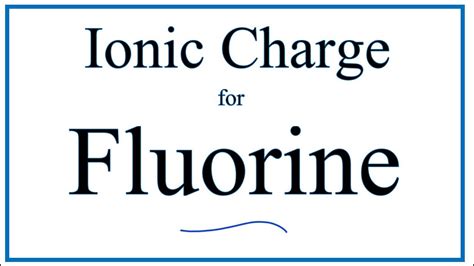Fluorine is a chemical element with the symbol F and atomic number 9. It is the lightest halogen and has a distinctive yellow-green color. Fluorine is highly reactive and forms compounds with most other elements.

Fluorine was first isolated by French chemist Henri Moissan in 1886. He produced fluorine by passing an electric current through a solution of potassium fluoride (KF) and hydrogen fluoride (HF). The electrolysis of KF and HF produces fluorine gas, which was collected by Moissan in a glass vessel.
Fluorine is a very reactive element and can react with most other elements, including metals, nonmetals, and organic compounds. Fluorine reacts with hydrogen to form hydrogen fluoride (HF), with oxygen to form oxygen difluoride (OF2), and with carbon to form carbon tetrafluoride (CF4). Fluorine also reacts with water to form hydrofluoric acid (HF), which is a highly corrosive acid.
The charge of fluorine is -1. This means that fluorine atoms have one extra electron than protons. The extra electron makes fluorine atoms highly reactive and attracted to positive ions. Fluorine is often found in ionic compounds, where it is bonded to positively charged ions such as sodium, potassium, and calcium.
Applications of Fluorine
Fluorine is used in a wide variety of applications, including:
- Refrigerants: Fluorine-containing compounds are used as refrigerants in refrigerators, air conditioners, and heat pumps.
- Propellants: Fluorine-containing compounds are used as propellants in aerosol cans and fire extinguishers.
- Plastics: Fluorine-containing plastics are used in a variety of applications, including coatings, films, and tubing.
- Pharmaceuticals: Fluorine-containing compounds are used in a variety of pharmaceutical drugs, including antibiotics, antidepressants, and antipsychotics.
- Electronics: Fluorine-containing compounds are used in a variety of electronic devices, including transistors, capacitors, and resistors.
Health Effects of Fluorine
Fluorine is a toxic gas that can cause serious health effects if inhaled. Inhalation of fluorine can cause irritation of the eyes, nose, throat, and lungs. In severe cases, inhalation of fluorine can lead to pulmonary edema, a condition in which fluid accumulates in the lungs.
Fluorine can also be harmful if ingested or if it comes into contact with the skin. Ingestion of fluorine can cause gastrointestinal irritation, nausea, vomiting, and diarrhea. Contact with fluorine can cause skin irritation, burns, and blisters.
Environmental Impact of Fluorine
Fluorine is a major pollutant that can have a significant impact on the environment. Fluorine emissions from industrial sources can contribute to air pollution and acid rain. Fluorine can also contaminate water supplies and soil.
The environmental impact of fluorine is a growing concern, and there are a number of regulations in place to limit fluorine emissions. These regulations include the Clean Air Act, the Clean Water Act, and the Resource Conservation and Recovery Act.
Tips and Tricks for Working with Fluorine
Fluorine is a dangerous and reactive chemical that should be handled with care. The following tips and tricks will help you work with fluorine safely:
- Always wear appropriate personal protective equipment (PPE) when working with fluorine. This includes a respirator, gloves, safety glasses, and a lab coat.
- Work in a well-ventilated area. Fluorine is a toxic gas that can cause serious health effects if inhaled.
- Never mix fluorine with other chemicals. Fluorine can react with a variety of chemicals, and these reactions can be dangerous.
- Store fluorine in a cool, dry place. Fluorine is a corrosive gas that can damage containers if it is not stored properly.
- Dispose of fluorine waste properly. Fluorine waste should be disposed of in accordance with local regulations.
FAQs about Fluorine
What is the atomic number of fluorine?
The atomic number of fluorine is 9.
What is the symbol for fluorine?
The symbol for fluorine is F.
What is the charge of fluorine?
The charge of fluorine is -1.
What are some of the applications of fluorine?
Fluorine is used in a wide variety of applications, including refrigerants, propellants, plastics, pharmaceuticals, and electronics.
What are some of the health effects of fluorine?
Fluorine is a toxic gas that can cause serious health effects if inhaled, ingested, or if it comes into contact with the skin.
What are some of the environmental impacts of fluorine?
Fluorine is a major pollutant that can have a significant impact on the environment. Fluorine emissions from industrial sources can contribute to air pollution and acid rain. Fluorine can also contaminate water supplies and soil.
How can I work with fluorine safely?
Always wear appropriate personal protective equipment (PPE) when working with fluorine. Work in a well-ventilated area. Never mix fluorine with other chemicals. Store fluorine in a cool, dry place. Dispose of fluorine waste properly.
Where can I find more information about fluorine?
There are a number of resources available online where you can find more information about fluorine. Some of these resources include:
- The National Institute for Occupational Safety and Health (NIOSH)
- The Environmental Protection Agency (EPA)
- The American Chemical Society (ACS)
